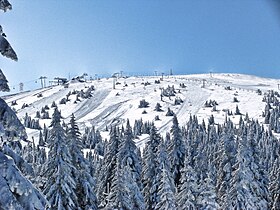Kopaonik
| Kopaonik | |
|---|---|

Pančić's Peak, during winter
|
|
| Highest point | |
| Peak | Pančić's Peak |
| Elevation | 2,017 m (6,617 ft) |
| Coordinates | 43°16′09″N 20°49′21″E / 43.26917°N 20.82250°ECoordinates: 43°16′09″N 20°49′21″E / 43.26917°N 20.82250°E |
| Geography | |
| Location | Serbia and Kosovo |
|
IUCN category II (national park)
|
|

Kopaonik National Park
|
|
| Area | 118.1 km2 (45.6 sq mi) |
| Established | 1981 |
| Kopaonik ski resort | |
|---|---|

Nebeske Stolice hotel at Kopaonik
|
|
| Location | Kopaonik, |
| Nearest city | Brus, Serbia |
| Coordinates | 43°16′9″N 20°49′21″E / 43.26917°N 20.82250°E |
| Top elevation | 2,017 m |
| Base elevation | 1,770 m |
| Skiable area | 62 km |
| Runs | 24 |
| Longest run | 3.5 km |
| Lift system | 28 total (8-passenger gondola (u/c), 3 high-speed 6-passenger Superchairs, 7 High-speed quad chairs, 2 double chairs, 11 Surface and 3 kid-surface) |
| Lift capacity | 32,000/hour |
| Website | Kopaonik |
Kopaonik (Serbian Cyrillic: Копаоник, Serbian pronunciation: [kɔpaɔ̌niːk], [kɔ̌paɔniːk]; Albanian: Kopaoniku) is one of the larger mountain ranges of Serbia and Kosovo. It is located in the central part of Serbia and the northern parts of Kosovo. Its highest point, Pančić's Peak, is 2,017 m (6,617 ft) above sea level and is located on the border between the two countries.
Kopaonik is the major ski resort of Serbia, and after Bulgaria's Bansko, largest in Southeast Europe. There are 25 ski lifts with capacity of 32,000 skiers per hour. A national park spread over 118.1 km2 (45.6 sq mi) of the central part of the Kopaonik plateau was established in 1981.
Kopaonik is the largest and longest mountain range in Serbia (120 km). It belongs to the region of Raška. The Kopaonik mountain massif (Kopaoničke planine) includes the mountains of Kopaonik, Željin, Goč and Stolovi. Snow exists between November and May, while there are 200 sun days.
Kopaonik has a rich historical heritage. The area was an important mining center in the Middle Ages with a notable Saxon community operating in the area. There was intensive trade with the Republic of Ragusa.
Besides old churches and monasteries like Đurđevi stupovi, Studenica monastery, Sopoćani and Gradac Monastery, there are also several early and medieval fortresses that can be found on the heights, built by Serbian dynasties. The nearest Serbian medieval castle is Maglič.
...
Wikipedia

